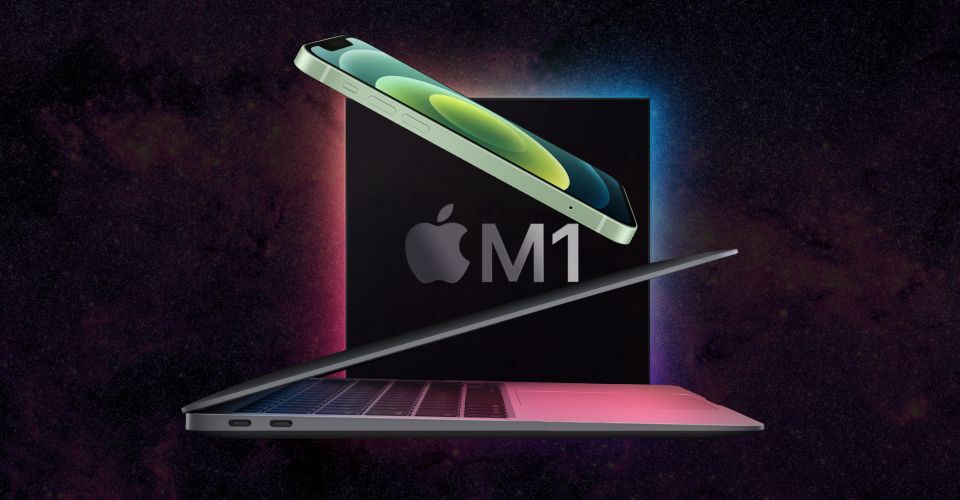M1 Vs. A14 Bionic: How Apple’s Mac Silicon Compares To iPhone 12 Chip

Apple’s powerful new M1 chip has made headlines as the first Apple Silicon to be used in Mac computers, but the iPhone 12’s A14 was released just one month earlier. Apple still has desktops and one laptop that use Intel processors, but this new technology is based upon Apple’s A-series chips. For example, it’s quite similar to the A14 processor found in Apple’s new iPhone 12 and iPad Air 4. The A14 itself is remarkably powerful as a mobile chip, but differs from the M1 in a few key areas.
Apple is no stranger to changing architectures. Mac computers, originally known as Macintosh computers, started with a Motorola 68000 chip, before transitioning several years later to the PowerPC, a joint project between Apple, Motorola, and IBM that provided an alternative to Intel’s dominant x86 processors. In 2006, the Mac joined the majority of the desktop and laptop market in using Intel CPUs. At each stage, Apple eased the transition for users and developers by providing an emulator that allowed the newer chip architectures to run apps designed for the previous generation of processors. Now another big conversion is happening and possibly for the last time, as Apple moves all CPU development in-house to Apple Silicon.
The M1 chip is more than just a CPU, it’s a system on a chip. The M1 SoC contains a CPU for primary processing tasks and a GPU that specializes in graphics. It also has a Neural Engine that handles artificial intelligence needs, such as understanding spoken commands, analyzing images, and collecting relevant information from large amounts of data. Beyond processing cores, the chip has a large memory cache to speed up access to instructions and data, as well as several special components that Apple hasn’t detailed for the public, making it powerful enough to replace the Intel Core i7 chips powering the MacBook Air and MacBook Pro from early 2020. The iPhone 12’s A14 has lower performance than the M1, but the design is basically the same. However, simply placing an A14 in a MacBook would not have the speed potential of the M1. The biggest factors when designing a chip are performance needs, thermal design, and power availability.
M1 Vs. A14 Battery & Thermal Design Limits

The M1 and A14 are similar chips, but work within different devices. The M1 MacBook computers have more room for larger batteries and the Mac mini, being a desktop model, has continuous power. On the other hand, the A14 must draw power from a battery as small as that of the iPhone 12 mini. While it also powers the iPad Air 4, the design had to consider the smallest-sized battery. That means the amount of power drawn is intentionally restricted for smartphones. The A14 is very powerful despite this limitation, but the M1 has that much more available to channel into performance. Thermal design must be considered for every computer, even large desktop models, and the size of the device is a big factor in how much heat can be handled.
Computer components perform best and last longest when they are kept at reasonable temperatures. That’s why overclocking CPUs and GPUs can lead to early failure. Of course, various cooling techniques are used to move heat away, but using a fan to remove hot air or pumping cool liquid through the device are best. A fan-cooled iPhone is not likely, so that means temperature places a hard line at how hot the A14 can get. The M1 is used in the MacBook Air which is much larger than an iPhone and does not contain a fan. It’s very impressive for such a high-performance device to be fan-less, but it also means it will be more likely to switch from its performance cores to the efficiency cores, which use one-tenth the power and therefore should generate much less heat. The MacBook Pro and the Mac mini contain fans so they should be able to sustain maximum performance for longer.
The two new Apple chips serve different device categories. The A14 is optimized for small devices without significant cooling options and limited battery size. The M1 is made for much larger devices with greater battery capacity, possibly plug-in power and fans. That means the restrictions have loosened considerably. The transistor count can go up, the number of cores can be increased, and specialty components can be added. The A14 has six-cores geared for performance and two with efficiency in mind. The M1 contains four performance cores and four for efficiency. All cores can work together to deliver maximum performance and efficiency, depending on the task at hand. GPU cores number four for the A14 and eight for the M1, and each has a 16-core Neural Engine. Just by physical core count, it’s easy to understand how the M1 can outperform the A14 in multi-core tasks.
However, the design advanced in more than just the number of cores. Allowing for more energy throughput and size means common CPU, GPU, and Neural Engine tasks can be moved into Apple’s custom components. Apple is continually refining the design of each individual core. Apple states that each efficiency core delivers similar performance as the 10th-generation Intel Core i3–1000NG4 used in the previous MacBook Air. That means the M1 is blazing fast, despite running cool enough to be used in a fan-less laptop design. The M1 is based on the A14, but with energy and thermal restrictions much looser, Apple was able to create a much faster processor.
Source: Apple
About The Author

















